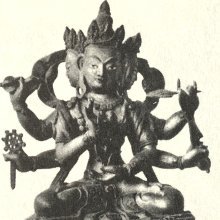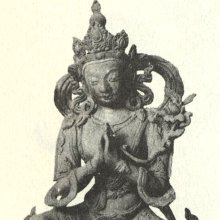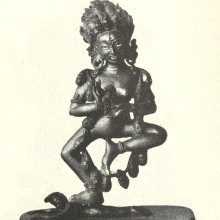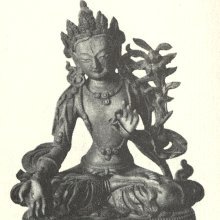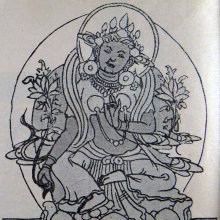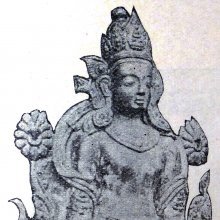Pandaravasini, Pandara-vasini, Pāṇḍaravāsinī: 5 definitions
Introduction:
Pandaravasini means something in Buddhism, Pali, Hinduism, Sanskrit. If you want to know the exact meaning, history, etymology or English translation of this term then check out the descriptions on this page. Add your comment or reference to a book if you want to contribute to this summary article.
Images (photo gallery)
In Buddhism
Tibetan Buddhism (Vajrayana or tantric Buddhism)
Source: Wisdom Library: Tibetan BuddhismPāṇḍaravāsinī (पाण्डरवासिनी) is the name of Vidyārājñī (i.e., “wisdom queen”) mentioned as attending the teachings in the 6th century Mañjuśrīmūlakalpa: one of the largest Kriyā Tantras devoted to Mañjuśrī (the Bodhisattva of wisdom) representing an encyclopedia of knowledge primarily concerned with ritualistic elements in Buddhism. The teachings in this text originate from Mañjuśrī and were taught to and by Buddha Śākyamuni in the presence of a large audience (including Pāṇḍaravāsinī).
Source: archive.org: The Indian Buddhist IconographyPāṇḍaravāsinī (पाण्डरवासिनी) or Pāṇḍarā is the Śakti, or female counterpart (spiritual consort) of Amitābha: one of the Dhyāni-Buddhas, according to Vajrayāna or Tantric Buddhism.—Her colour is red; and her symbol is a lotus.—Pāṇḍarā is also called Pāṇḍaravāsinī. According to a Dhyāna in the Advayavajrasaṃgraha she belongs to the Lotus family which is also the family of the Dhyāni Buddha Amitābha. Pāṇḍarā thus is the spiritual consort of Amitābha.
Pāṇḍaravāsinī’s form and nature are described as under:—“In the Vāyu corner on the orb of the moon there is Pāṇḍaravāsinī originating from the (red) germ syllable Pāṃ. She is redin colour and has the Padma (lotus) as her recognition symbol. She is the embodiment of the element of Fire. She belongs tothe Lotus family and is full of attachment”.
Source: Wisdomlib Libary: VajrayoginiPāṇḍaravāsinī (पाण्डरवासिनी) is the presiding deity of the southern lotus of the vārāhyabhyudaya-maṇḍala, according to the Vārāhyabhyudayatantra (largerly extracted from the 10th century Abhidhānottaratantra). She is the presiding lady (kuleśvarī) of the śāśvata (Vairocana) family. The central deity of the vārāhyabhyudaya-maṇḍala is the twelve-armed Vajravarāhī, which is modeled upon the twelve-armed Cakrasaṃvara, thus inhibiting many similar iconographical features.
Pāṇḍaravāsinī has three faces of three colors (white, blue and red) and is to be visualised as naked and wearing only a agarland of heads, dancing upon the four māras. She has six arms and her attributes include the cihnam (family emblem), the vajra, the double vajra, a red lotus and a wheel.
The lotus upon which Pāṇḍaravāsinī presides has 6 petals and corresponding goddesses residing in pīṭhas (sacred site):
- Śauṇḍinī in Saurāṣṭra,
- Cakravarmiṇī in Suvarṇadvīpa,
- Suvīrā in Nagara,
- Mahābalā in Sindhu,
- Cakravartinī in Maru,
- Mahāvīryā in Kulatā.
Pāṇḍaravāsinī (पाण्डरवासिनी) is another name for Pāṇḍarā or Pāṇḍarī: a Ḍākinī who, together with the Vīra (hero) named Pāṇḍara forms one of the 36 pairs situated in the Hṛdayacakra, according to the 10th century Ḍākārṇava chapter 15.

Tibetan Buddhism includes schools such as Nyingma, Kadampa, Kagyu and Gelug. Their primary canon of literature is divided in two broad categories: The Kangyur, which consists of Buddha’s words, and the Tengyur, which includes commentaries from various sources. Esotericism and tantra techniques (vajrayāna) are collected indepently.
Languages of India and abroad
Sanskrit dictionary
Source: Cologne Digital Sanskrit Dictionaries: Edgerton Buddhist Hybrid Sanskrit DictionaryPaṇḍaravāsinī (पण्डरवासिनी).—see Pā°.
--- OR ---
Pāṇḍaravāsinī (पाण्डरवासिनी).—or Paṇḍ°, name of a Buddhist goddess, associated with Tārā (Mahāvyutpatti 4279; (Ārya-)Mañjuśrīmūlakalpa 621.19), with Avalokiteśvara ((Ārya-)Mañjuśrīmūlakalpa 40.7); probably the same as Pāṇḍarā or Pāṇḍurā: Mahāvyutpatti 4279; Sādhanamālā 75.8; Paṇḍ° (Ārya-)Mañjuśrīmūlakalpa 40.7; 611.1; 621.19.
Source: Cologne Digital Sanskrit Dictionaries: Monier-Williams Sanskrit-English DictionaryPāṇḍaravāsinī (पाण्डरवासिनी):—[=pāṇḍara-vāsinī] [from pāṇḍara-vāsin > pāṇḍara > pāṇḍu] f. Name of a, [Buddhist literature] Tantra deity, [cf. Lexicographers, esp. such as amarasiṃha, halāyudha, hemacandra, etc.]
Sanskrit, also spelled संस्कृतम् (saṃskṛtam), is an ancient language of India commonly seen as the grandmother of the Indo-European language family (even English!). Closely allied with Prakrit and Pali, Sanskrit is more exhaustive in both grammar and terms and has the most extensive collection of literature in the world, greatly surpassing its sister-languages Greek and Latin.
See also (Relevant definitions)
Partial matches: Vashini, Pandara, Vacini.
Full-text: Pandara, Pandaravasa, Nagara, Cakravarmini, Suvira, Pandari, Sindhu, Mahavirya, Cakravartini, Shaundini, Kulata, Maru, Mahabala, Saurashtra, Suvarnadvipa, Kuluta, Padmapani, Padmanartteshvara.
Relevant text
Search found 6 books and stories containing Pandaravasini, Pandara-vasini, Pāṇḍara-vāsinī, Paṇḍara-vāsinī, Pāṇḍaravāsinī, Paṇḍaravāsinī; (plurals include: Pandaravasinis, vasinis, vāsinīs, Pāṇḍaravāsinīs, Paṇḍaravāsinīs). You can also click to the full overview containing English textual excerpts. Below are direct links for the most relevant articles:
Vietnamese Buddhist Art (by Nguyen Ngoc Vinh)
1. Physical appearance of Avalokitesvara < [Chapter 3 - Unifying factors of the Avalokitesvara Images in South Vietnam and South East Asia]
Blue Annals (deb-ther sngon-po) (by George N. Roerich)
Chapter 9 - The Tibetan emperors prophesied in the Mūlatantra < [Book 1 - The beginning of the story of the Doctrine]
The Great Chariot (by Longchenpa)
Part 4a.3 - Meditating on the deities < [B. The explanation of meditation practice, together with its action of ripening and freeing]
Part 4a.4 - The great mandala of the environment and inhabitants < [B. The explanation of meditation practice]
Part 3d.2c - The perfect teacher < [B. The explanation of the kayas and wisdoms]
The Indian Buddhist Iconography (by Benoytosh Bhattachacharyya)
Guhyagarbha Tantra (with Commentary) (by Gyurme Dorje)
Text 8.11-12 (Commentary) < [Chapter 8 (text and commentary)]
Text 4.18 (Commentary) < [Chapter 4 (text and commentary)]
Text 8.21 (Commentary) < [Chapter 8 (text and commentary)]
A Dictionary Of Chinese Buddhist Terms (by William Edward Soothill)
